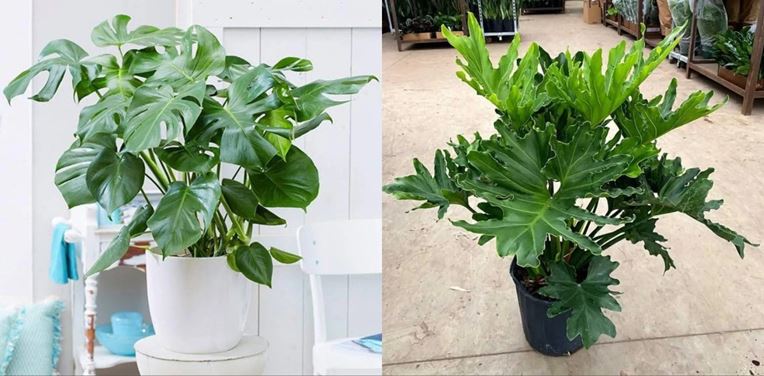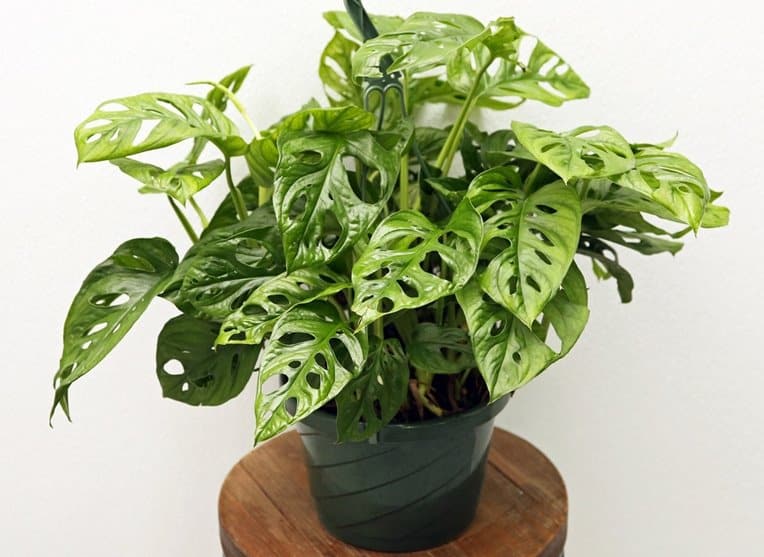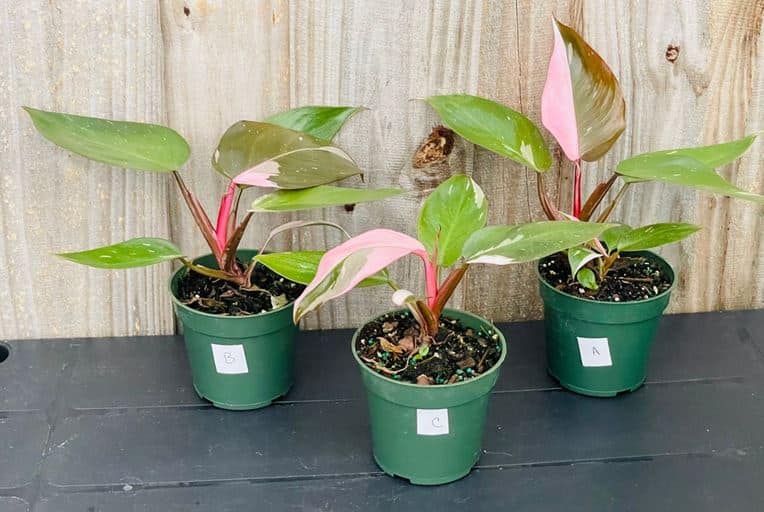Monstera vs. Philodendron will help you know how to tell the difference between these two plants and give you a deeper insight into each species. Why? Because many people mislabel species in these two plant genera.
The other common confusion is split-leaf Philodendron and Monstera. We decided to have it differently. Why? Because the true split-leaf Philodendron is now a Thaumatophyllum bipinnatifidum just as Xanadu.
We will talk about Monstera and Philodendron care and growth requirements towards the end. They are more or less similar.

Contents
- Why the confusion
- About Monsteras
- About Philodendron
- What may not tell differences
- 1. Leave shapes, size, color, and size
- 2. Growing habits
- 3. Stems
- Monstera vs. philodendron similarities
- Monstera vs. Philodendron differences
- 1. Look for fenestration
- 2. Geniculum
- 3. Perfect vs. imperfect flowers.
- 4. Growth rate
- 5. Edible fruits
- 6. Persistent cataphylls vs. deciduous
- Monstera vs. philodendron care and growth requirement
- 1. USDA hardiness zone
- 2. Temperature
- 3. Humidity
- 4. Light
- 5. Soil
- 6. Watering
- 7. Fertilizer
- 8. Pruning
- 9. Repotting
- 10. Support
- Should I pick a Monstera or a Philodendron?
Why the confusion
Many people confuse Monstera and Philodendron because of the resemblance they bear and their common names. You will find Monstera species with philodendron names.
For instance, Monstera adansonii is also known as Cheese Swiss philodendron. And Monstera deliciosa goes by the name split-leaf Philodendron.
On the other hand, you will find the Pink Princess Philodendron, labeled as pink Monstera.
About Monsteras
Monstera is a plant genus with about 45 hemiepiphytes species native tropical American rainforests (Central and South America, including Caribbean islands and parts of Southern Mexico). Hemiepiphytes are plants with two growth phases, i.e., grow both on the grows (terrestrial) and as epiphytes (on other plants but not parasitically).

It belongs to the arum family Araceae (aroids), with lovely houseplants species. They are easy to care for and air purifying.
Monstera is a Latin word that means monstrous, referring to the abnormal or fenestrated (having holes, windows, or perforations) leaves that most species have.
Monstera plant leaves come in varying sizes, colors, textures, and shapes. Baby or young Monstera leaves are primarily entire, but some may have holes early or splits.
On the other hand, Mature Monstera leaves are dramatically large and may have split (pinnatifid or have fenestration (holes or windows). For instance, M. deliciosa or dubia have both perforations and splits.
On the other hand, some like M. adansonii, acuminata, var. laniata, obliqua, siltepecana, lechleriana, acacoyaguensis are fenestrated leaves with an entire margin.
That is not all. Some mature leaves, especially of M. subpinnata, have split leaves with holes. And some like M. Peru don’t show much change in juvenile and adult stages.
About Philodendron
Philodendron is the second-largest genera (after Anthurium) in the Araceae family with over 450 species. It grows mainly as epiphytes or hemiepiphytes and rarely as terrestrial plants.
Like Monsteras, it is native to neotropical forests. Also, it has many lovely houseplants such as P. Hederaceum, bipinnatifidum, mican, brasil, gloriosum, selloum, and the Pink Princess Philodendron, the plant some people label as pink Monstera.

That is not all. Philodendron comes from two Greek words, Philo, meaning love or affection, to describe the heart-shaped leaves, and dendron, meaning tree. But not all species have heart-shaped leaves. Others have lance-shaped, lobbed, oblong, oval, and many other possible shapes.
Last but not least, you will find Philodendron species that are stout climbers, and others grow more like vines, just as pothos do.
What may not tell differences
Before we give you the differences between Monstera and Philodendron, discussing things you may not use unless specific to a species is good.
1. Leave shapes, size, color, and size
You cannot use leaf size, color, shape, or texture to differentiate Monstera and Philodendron. Why? Because leaf shapes, color, texture, and sizes vary from one species to another.
It is only possible to use leaves to draw differences between unique species such as Philodendron selloum vs. Monstera deliciosa.
2. Growing habits
It is true some philodendrons grow as stout plants. So does M. deliciosa. Also, some, such as heart-leaf philodendron (P. hederaceum), grow more like a vine. You will also find Monsteras that grow like vines.
3. Stems
Depending on the exact species you are talking about, these two genera may have a vine-like or stout stem. So, saying one is vine-like, another stout doesn’t cut the difference.
Monstera vs. philodendron similarities
Before you know the differences, we want to talk about similarities. They are the reason that causes the mix-up.
Both Monsteras and philodendrons have aerial roots, are mostly climbers, belong to the same Araceae family. Also, they are native to the Americas and have cataphylls.
The other similarity is that they are toxic to cats, dogs, other pets, or even humans. Why? Because they have insoluble calcium oxalate that will cause severe oral irritation, swelling, pain, etc. if chewed.
That is not all. Both Monstera and Philodendron have flowers borne on a spadix and surrounded by a spathe. But the exact color may vary.
Monstera vs. Philodendron differences
It’s time to look at the differences. We will discuss those you can see and those you may not. Here is how to quickly tell a Monstera from Philodendron.
1. Look for fenestration
Most Monsteras have fenestrations (holes or perforations) except M. subpinnata and M. Peru. Philodendrons, on the other hand, don’t have fenestrations.
M. Peru juvenile and mature leaves look a line (they don’t get large). Also, M. standleyana may not have holes as well as M. spruceana.
2. Geniculum
All Monsteras have a geniculum (a knee-like bend near petiole joins leaf base), but philodendrons don’t, except Philodendron geniculatum, a newly accepted species. The geniculum helps turn the leaves towards the light.
3. Perfect vs. imperfect flowers.
You may not be able to observe this difference. But you need to know that Monstera has perfect flowers, i.e., flowers have a set of male and female organs.
On the other hand, philodendron flowers are imperfect, meaning they have one set of sexual organs, i.e., they are either male or female.
4. Growth rate
Philodendron species grow faster than Monstera. They will add up to about 4 inches a week during the growing season like summer. This growth rate is faster than Monsteras, which will grow by about 1-2 feet a year!
That said, don’t forget to provide optimum care and growing conditions.
5. Edible fruits
Both plants flower and produce fruits. But one Monstera species, the M. deliciosa, has edible fruits.
On the other hand, none of the Philodendron species has edible fruits. So if you hear edible fruits, know it is a Monstera.
6. Persistent cataphylls vs. deciduous
Both plants have cataphylls. In Monstera, they persist, i.e., they will remain intact after they dry. But for some philodendrons, the cataphylls fall.
Unfortunately, using cataphylls alone may not help differentiate these two aroid species.
Bottom line: Monstera has fenestrations (holes), a geniculum, and perfect flowers. Also, they grow slower, cataphylls persist and M. deliciosa has edible fruits. Philodendrons don’t have fenestrations, geniculum (except one) and grow faster. Their fruits are not edible, flowers are imperfect and some species have decidous cataphylls.
Monstera vs. philodendron care and growth requirement
The other area you may want to know is how their care needs differ. You would probably need one that is easier to care for or has lower maintenance.
If care needs are the reason you want to decide on which of these two genera you will pick, you should know that their care needs are very similar.
Here is a summary of Monstera and Philodendron care growth and requirements:
1. USDA hardiness zone
Their USDA hardiness zone is 10B to 11. Freezing temperatures and frost will destroy the plants. Only in these zones can you grow them outdoor all year.
2. Temperature
The ideal temperature should be 65 to 85 degrees Fahrenheit (18 to 29°C). These aroids won’t grow at 50 °F (10 °C) or below. Also, they don’t like sudden temperature changes, cold drafts, or places that emit heat, like heating system vents.
3. Humidity
Besides a warm place, you need to give them average to above average humidity, i.e., 50% or more. Use a humidifier like Pure Enrichment® MistAire, LEVOIT or Aquaoasis if your home has very low humidity. It will also benefit you.
Other ways to raise humidity include misting your plant a couple of times a week or using a pebble tray. Also, you can move plants to the bathroom, kitchen, or rooms with higher humidity, or you can put your plants together.
4. Light
They need bright, indirect light. But most will tolerate medium to low light except for variegated varieties, i.e., always give your variegated Monstera and Philodendron bright, indirect light.
Avoid direct sunlight as it causes leaf scorch. Outdoors, please give these plants a shade. Indoors, place them at a distance from the window.
For too little light, buy Relassy 15000Lux Sunlike Full Spectrum Grow Lamp grow lights or any other good light.
5. Soil
Give your Monstera and Philodendron, chunky, well-drained soil high in organic soil. It should also be slightly acid to neutral.
Buy an aroid mix (see Etsy.com) or makes your. A mixture of perlite, sphagnum moss, bark chips, and worm castings should work. Remember these aroids are not so fussy on the soil you give them as long as it drains, is airy, and has compost.
6. Watering
It would help if you took a lot of care since overwatering will cause root rot. On the other hand, underwatering may harm your plant’s health.
Water these aroids when the potting mix’s top 2-3 inches is dry. Don’t follow a schedule because water needs vary.
Instead test the soil and water when the potting mix feels dry up to the first knuckle of your finger. A better way is to use a soil moisture meter like Gouevn, XLUX or Sonkir.
Lastly, when watering, saturate the soil until excess flows from the drainage holes. Don’t forget to pour any that collects on the saucer.
7. Fertilizer
Feed these plants once a month with an all-purpose indoor houseplant fertilizer in spring or summer (growing season). Please don’t feed them in winter.
You can use Miracle-Gro Indoor Plant Food (Liquid). It will feed your plants instantly. Also, if you use it correctly, it will never burn your these plants.
8. Pruning
Use a sterilized pruning shear to cut brown, yellow, diseased, dead, or damaged leaves. If brown tips and edges, trim the brown areas only.
You can cut back a few branches in the growing season to control growth and encourage a fuller plant (branching).
9. Repotting
When young, repot your Monstera or Philodendron yearly. Afterward, you can repot these aroids after two years or when rootbound.
The best time to repot is spring or summer. Pick a pot 2 to 3 inches wider in diameter.
10. Support
As climbers, these plants will appreciate a stake. But it is not mandatory. You can let them cascade onto your table, cabinet, or even use a hanging basket.
For support, you can go for a burlap wrapped or moss pole. Also, the cedar and bamboo poles are good. Use a soft string, twine, or twist to train your plant.
Should I pick a Monstera or a Philodendron?
As you have seen, both plants require similar care needs. Which one you pick is a matter of pure choice. Also, you will get variegated and non-variegated ones.
If you love plants with fenestrations, go for Monstera, especially the Swiss cheese plants (M. deliciosa, obliqua, or adansonii).
On the other hand, if you love vining plants, go for Heartleaf Philodendron or micans. Although non-vining, we love Birkin.





Leave a Reply